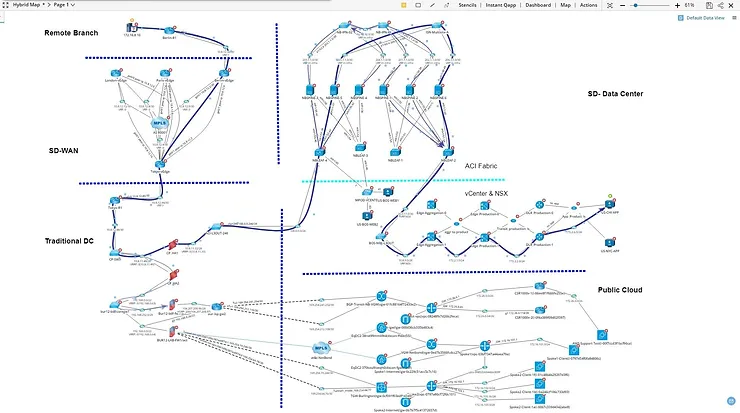4 Phases of a Data Center Migration

Moving or migrating a data center
Let's start with some basic terminology, so we are all on the same page.
A data center migration (also called a relocation or move) is simply the act of either physically or virtually moving your technology infrastructure (network, storage, compute, applications, and data) from one location to another location, such as:
-
An on-site data center to a colocation facility
-
From one floor to another floor
-
Moving a small sub-set of infrastructure to an EDGE environment
-
Logically moving application from on-premise hardware to a public or private cloud (A separate post will be done on this soon)
A data center consolidation is the act of moving multiple data centers and the infrastructure into a fewer number of data centers (e.g. Going from 4 regional data centers, down to 2 domestic data centers) via multiple data center migrations.
Why do organizations migrate / relocate their data centers?
There are multiple reason for organizations to migrate their data centers. The colocation industry continuously is undergoing changes, and colocations are closing buildings down that aren't profitable or need to much repair. Sometimes organizations are looking to downsize their physical environments as cloud initiatives and technology is constantly evolving. The reasons why organizations move isn't as important as once the decision is made, HOW do you move a data center?
There are really only four phases of all migrations. Data center migrations, cloud migrations, application migrations, and even data migrations, all come down to four phases. At Vsol we call this process M.O.V.E. Manifest, Orchestrate, Validate and Execute. We know it's cheesy, but in over a thousand (yes, over a thousand) migations it has not failed us yet.
Now there are a lot of steps, activities and deliverables that differ quite a bit between the different migrations, and between each organization's migration. Every migration is unique in the challenges it will present.
So what does M.O.V.E. really mean?
Manifest
In the logistics world, every truck, ship, train, plane, etc. must have a manifest of what it is carry. This phase for migrations is no different. Organizations need to understand;
-
Team members and responsibilities
-
Budget and stakeholders
-
Assets and location of assets
-
Virtual assets and workload information
-
Infrastructure dependencies
-
Migration Business requirements
-
Migration approaches (Lift and ship, phased migration, physical to virtual, disaster recovery failover, etc.)
These are a few of the critical items that need to be determine, documented, communicated and analyzed before the real planning work can begin.
Orchestrate
Even birds have a plan when they migrate. Orchestrate is the detailed analysis and planning phase. While manifest gives you the details you need, orchestrate is where attention to every detail is critical
-
Application dependency or migration bundles
-
Workload analysis or re-platform analysis
-
New data center design (rack elevations, cable matrix, etc.)
-
OEM integration - Vendors like EMC, Hitachi.
-
Network architecture, Seed equipment, security architecture, etc.
-
Electrical and Mechanical reviews of new space to ensure capacity
-
Procurement of equipment, cables, structured cabling
-
Transportation arrangement (physical moves)
-
Contingency planning
Any yes, there are a lot more steps. This phase is where you will spend the majority of your time. But as I'm sure you have already started to understand, without solid data from the manifest phase, the orchestration phase can become a nightmare.
Validate
"Measure twice, Cut Once" is what my grandfather would repeat over and over to me as young kid growing up on the farm. The validate phase is our measure twice.
-
Build the shutdown and startup sequences
-
Run books by 15 minute increments with every activity to be performed
-
Align and ensure insurance policies are in place
-
Initial or "Current State" application and end user testing (serves as a baseline)
-
Run simulations (via software or table top exercise) of migration events
-
Perform pre-migration activities (labels, cablings, backups, etc.)
-
Communicate, communicate, communicate
A migration is similar to a wedding, no matter how much you plan something is probably going to go wrong, but Orchestrate and Validate will give you the confidence that it will complete successfully.
Execute
This is our "Cut Once", where the planning and preparation will show itself. It's game day (or night or weekend)!
-
Success Rooms (people call them war rooms, but you've done the planning!)
-
Shutdowns, de-installs, packaging (for physical moves)
-
Logistics, or data / application migration
-
Re-installs and cabling
-
Application startup sequencing
-
Testing (application and end-user) - compare again your baseline
-
Lessons learned
There are a lot of moving parts when it comes to any type of migration, but by applying the M.O.V.E. process you are always only four phases away from success. If you are overwhelmed, our team of migration specialists are always here to help. We offer solutions for the "Do it Ourselfer's" (those who have the resources, but just need a plan, a process and maybe a little help) to "All-in" (for those organizations that can't handle the extra workload of a migration.

